- europages
- >
- COMPANIES - SUPPLIERS - SERVICE PROVIDERS
- >
- prototyping
Results for
Prototyping - Import export

CIC - KLAUS CZERWONKA
Germany
Milling of complex components for automotive and mechanical engineering. Production of prototypes, test parts, small and large series according to data records, drawings, samples or specifications. Machining of cast and forged blanks. Attachment of decorative surfaces.
Request for a quote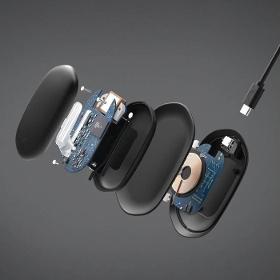
ENTRIVE STUDIO
Netherlands
The product development process heavily relies on prototyping. During the design, we go back and forth between 3D design and tangible prototypes, constantly improving the details. Early mock-ups are usually made of paper, cardboard or plastic leftovers that represent the rough functions and measurements of a product idea. Later we use 3D printing, lasercutting and other methods to create realistic prototypes that can be used to test the idea and the design. High quality prototypes can be used for product photography for your website or crowdfunding page. We have a large network of 3D printers, lasercutters, CNC operators, woodworkers, metal workers and more, to make sure that the prototype get as close to the final product as possible.
Request for a quote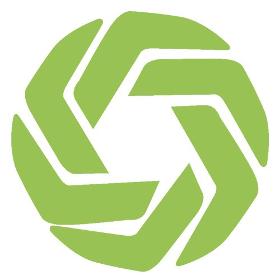
TOROID D.O.O.
Slovenia
Sometimes a functional prototype is needed for the design approval. With our in-house 3D Printing Capabilities, an own workshop, and several manufacturing partners, you do not waste any time and resources.
Request for a quote
3D HUBS - DIGITAL MANUFACTURING PLATFORM
Netherlands
Online 3D printing service from 3D Hubs: - technologies: FDM, SLA, MJF, SLS, DMLS, Polyjet - Materials: plastics (nylon, PLA, ABS, resin, PETG, TPU, ASA, PEI); metals (stainless steel, aluminium, titanium) - Upload CAD for instant quote and start production in 5 minutes.
Request for a quote
CAFUTA D.O.O.
Slovenia
Under prototypes we provide sheet-metal products and machining services.
Request for a quote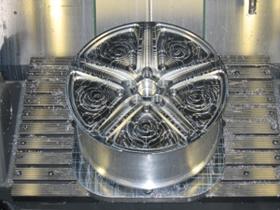
CIC - KLAUS CZERWONKA
Germany
Thanks to our expertise in mechanical production, we can provide you with effective support in the purchase and procurement of: supplier parts Prototypes Experimental parts Rapid prototypes Sample parts You can obtain these parts directly from us from our supplier network, or we will support you in procuring them from your suppliers by coordinating your development, purchasing, logistics and quality assurance.
Request for a quote
VOXELJET AG
Germany
• Mold measurements up to 4 x 2 x 1 m • Does away with elaborate and expensive mold set-ups • Short throughput time (a few days) • Sand molds correspond 1:1 with CAD model • Structures can be designed in accordance with requirements, without having to watch for draft angles or undercuts • Special sands prevent casting problems • Surface quality can be adjusted through use of different sands • Coarse-grained sands for high gas permeability • Considerable flexibility with changes in geometry, without additional expenses • No storage or maintenance of patterns • Cost savings particularly for complex molds and batch sizes of 1 to several hundred pieces
Request for a quote
VOXELJET AG
Germany
The VX2000 is a 3D printer for industrial applications. It is a particularly good choice for cost-effectively producing large-format models from sand cores for prototyping. The VX2000 can also be used to economically manufacture small-series components. The machine is fast and easy to operate. The build space measures up to 2,000 x 1,000 x 1,000 mm. The VX2000's print head system can achieve a resolution of up to 300 dpi. A layer applied in one cycle is 300 µm thick.
Request for a quote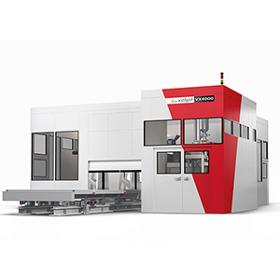
VOXELJET AG
Germany
The VX4000 is the world's biggest industrial 3D printing system for sand molds. It has a cohesive build space measuring 4,000 x 2,000 x 1,000 mm (LxWxH). This machine can be used to economically produce very large individual molds, a great many small series components or a combination of the two. With its uniquely large volume, the VX4000 maximizes productivity and flexibility. The unique and patented layering process was specially adapted for this printer. Instead of lowering the building platform during the printing process, the print head and coater are raised with each layer. As a result, the machine can bear the enormous weight of the building platform, which can be quickly exchanged via a rail—making it possible to print nearly continuously. Sand can be used as the particulate material. The VX4000's print head system can achieve a resolution of up to 300 dpi. A layer applied in one cycle is 300 µm thick.
Request for a quote
VOXELJET AG
Germany
The VX200 is the most compact 3D printer in the voxeljet portfolio. It weighs a mere 450 kilograms and, thanks to its dimensions of only 1,700 x 900 x 1,500 mm (LxWxH), the VX200 can be installed without problems in places where space is tight, such as research laboratories. The machine is very fast, easy to operate and permits the economical production of small prototypes and design pieces. Plastic and sand can be used as the particulate materials. The build space measures 300 x 200 x 150 mm. The VX200's print head system can achieve a resolution of up to 300 dpi. The thickness of a layer applied in one cycle is 150 µm for plastic and 300 µm for sand.
Request for a quote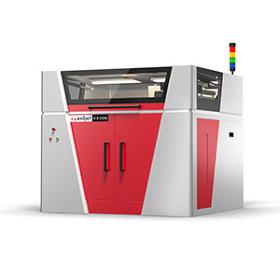
VOXELJET AG
Germany
The VX500 is a 3D printer for industrial applications that has been tried and tested many times over in practice. These machines can be found wherever there is a demand for the straightforward production of prototypes and models. Despite their compact dimensions, they captivate with the features of a high-performance printer, such as multi-jet print heads, integrated material handling and job boxes. The machine is very fast, easy to operate and permits cost-effective production of both individual parts and small series alike. Plastic can be used as the particulate material. The machine's build space measures 500 x 400 x 300 mm. The VX500's print head system can achieve a resolution of up to 600 dpi. The thickness of a layer applied in one cycle is 150 µm. In addition, the VX500 concept is resource-friendly: In plastic processes, the unprinted particulate material is recyclable.
Request for a quote
VOXELJET AG
Germany
Our international bestseller: the VX1000 is a universal 3D printer for industrial applications. The machine is fast, easy to operate and enables you to cost-effectively produce medium-sized molds, cores and models for making prototypes. The VX1000 is also suitable for producing small series. Plastic and sand can be used as the particulate material. The piezo print head system of the VX1000 achieves a resolution of up to 600 dpi. The machine's build space measures 1,000 x 600 x 500 mm. The thickness of a layer applied in one cycle is 150 µm for plastic and 300 µm for sand. In addition, the VX1000 concept is environmentally friendly: In plastic processes, the unprinted particulate material is recyclable.
Request for a quote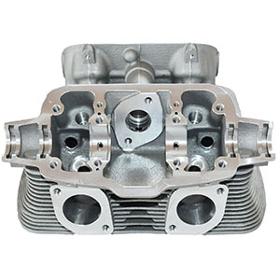
VOXELJET AG
Germany
• Mold measurements up to 4 x 2 x 1 m • Does away with elaborate and expensive mold set-ups • Short throughput time (a few days) • Sand molds correspond 1:1 with CAD model • Structures can be designed in accordance with requirements, without having to watch for draft angles or undercuts • Special sands prevent casting problems • Surface quality can be adjusted through use of different sands • Coarse-grained sands for high gas permeability • Considerable flexibility with changes in geometry, without additional expenses • No storage or maintenance of patterns • Cost savings particularly for complex molds and batch sizes of 1 to several hundred pieces
Request for a quote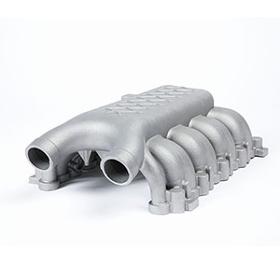
VOXELJET AG
Germany
• Mold measurements up to 4 x 2 x 1 m • Does away with elaborate and expensive mold set-ups • Short throughput time (a few days) • Sand molds correspond 1:1 with CAD model • Structures can be designed in accordance with requirements, without having to watch for draft angles or undercuts • Special sands prevent casting problems • Surface quality can be adjusted through use of different sands • Coarse-grained sands for high gas permeability • Considerable flexibility with changes in geometry, without additional expenses • No storage or maintenance of patterns • Cost savings particularly for complex molds and batch sizes of 1 to several hundred pieces
Request for a quote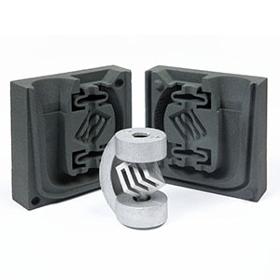
VOXELJET AG
Germany
• Mold measurements up to 4 x 2 x 1 m • Does away with elaborate and expensive mold set-ups • Short throughput time (a few days) • Sand molds correspond 1:1 with CAD model • Structures can be designed in accordance with requirements, without having to watch for draft angles or undercuts • Special sands prevent casting problems • Surface quality can be adjusted through use of different sands • Coarse-grained sands for high gas permeability • Considerable flexibility with changes in geometry, without additional expenses • No storage or maintenance of patterns • Cost savings particularly for complex molds and batch sizes of 1 to several hundred pieces
Request for a quote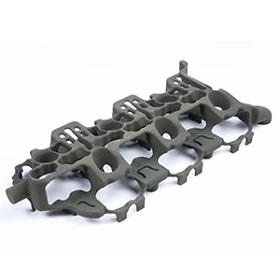
VOXELJET AG
Germany
• Mold measurements up to 4 x 2 x 1 m • Does away with elaborate and expensive mold set-ups • Short throughput time (a few days) • Sand molds correspond 1:1 with CAD model • Structures can be designed in accordance with requirements, without having to watch for draft angles or undercuts • Special sands prevent casting problems • Surface quality can be adjusted through use of different sands • Coarse-grained sands for high gas permeability • Considerable flexibility with changes in geometry, without additional expenses • No storage or maintenance of patterns • Cost savings particularly for complex molds and batch sizes of 1 to several hundred pieces
Request for a quote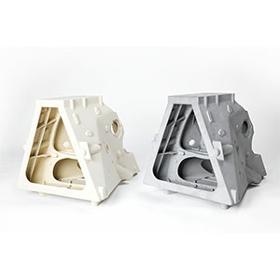
VOXELJET AG
Germany
• Model measurements up to 1.000 x 600 x 500 mm • Same handling as for conventional wax parts • Tool-less and hence more cost-effective process • Single items and small series can be produced within a few days • High degree of accuracy: ±0.4% (min. +/- 100 µm) • Wax infiltration creates closed smooth surface • Suitable for autoclaves, even for thin-walled shells • Can be burnt out in normal kiln with low emission formation • Does not expand during burn-out process, hence no shell cracking (whether gypsum or ceramics) • Residual ash contents <0.02% for polypor binder type C • All alloys can be used with lost-wax casting process
Request for a quoteDo you sell or make similar products?
Sign up to europages and have your products listed
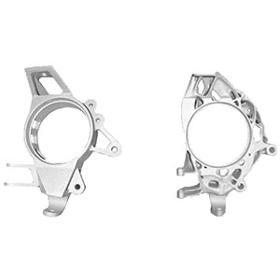
VOXELJET AG
Germany
• Model measurements up to 1.000 x 600 x 500 mm • Same handling as for conventional wax parts • Tool-less and hence more cost-effective process • Single items and small series can be produced within a few days • High degree of accuracy: ±0.4% (min. +/- 100 µm) • Wax infiltration creates closed smooth surface • Suitable for autoclaves, even for thin-walled shells • Can be burnt out in normal kiln with low emission formation • Does not expand during burn-out process, hence no shell cracking (whether gypsum or ceramics) • Residual ash contents <0.02% for polypor binder type C • All alloys can be used with lost-wax casting process
Request for a quote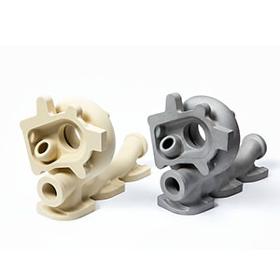
VOXELJET AG
Germany
• Model measurements up to 1.000 x 600 x 500 mm • Same handling as for conventional wax parts • Tool-less and hence more cost-effective process • Single items and small series can be produced within a few days • High degree of accuracy: ±0.4% (min. +/- 100 µm) • Wax infiltration creates closed smooth surface • Suitable for autoclaves, even for thin-walled shells • Can be burnt out in normal kiln with low emission formation • Does not expand during burn-out process, hence no shell cracking (whether gypsum or ceramics) • Residual ash contents <0.02% for polypor binder type C • All alloys can be used with lost-wax casting process
Request for a quote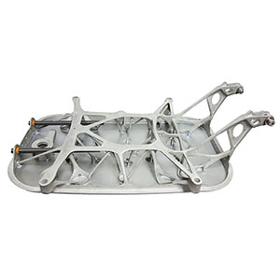
VOXELJET AG
Germany
• Model measurements up to 1.000 x 600 x 500 mm • Same handling as for conventional wax parts • Tool-less and hence more cost-effective process • Single items and small series can be produced within a few days • High degree of accuracy: ±0.4% (min. +/- 100 µm) • Wax infiltration creates closed smooth surface • Suitable for autoclaves, even for thin-walled shells • Can be burnt out in normal kiln with low emission formation • Does not expand during burn-out process, hence no shell cracking (whether gypsum or ceramics) • Residual ash contents <0.02% for polypor binder type C • All alloys can be used with lost-wax casting process
Request for a quote
VOXELJET AG
Germany
• Model measurements up to 1.000 x 600 x 500 mm • Same handling as for conventional wax parts • Tool-less and hence more cost-effective process • Single items and small series can be produced within a few days • High degree of accuracy: ±0.4% (min. +/- 100 µm) • Wax infiltration creates closed smooth surface • Suitable for autoclaves, even for thin-walled shells • Can be burnt out in normal kiln with low emission formation • Does not expand during burn-out process, hence no shell cracking (whether gypsum or ceramics) • Residual ash contents <0.02% for polypor binder type C • All alloys can be used with lost-wax casting process
Request for a quote
ENTRIVE STUDIO
Netherlands
We design market-changing products for startups who go on to become successful brands. Innovation and user-experience combined with knowing how to get products to production is where our expertise lies. Our expertise is working with startups and companies who want to work like startups. We’ve created a fast-paced innovative process that favours partnerships with clients where we can act as your in-house creative team and support the product development from strategy to manufacture. How is design for start-ups different from other design processes? - Our team is small but experienced, meaning you don't pay for a 4-person team of consultants when much less is needed. - We're ready to help you with low-volume production, even if you only want to make only 10 pieces as a start. - We work in close collaboration with you, with multiple approval steps, so you're always in the loop. - Design for unit price or for budget is no problem.
Request for a quote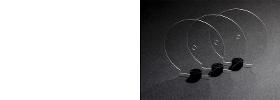
SHAPEYOURGLASS
Belgium
We offer highquality prototypes for industrial product development. Our inhouse design team will work along with you to define the best material and integration.
Request for a quote
ENTRIVE STUDIO
Netherlands
Developing physical products, from idea to manufacturing. Industrial design includes the visualisation of your idea, creating multiple style (appearance design) options, 3D design, CAD, rendering, prototyping, and making sure that the product is easily and efficiently manufacturable. We guide you through the product development process from start to finish and share our expertise to make sure your product launch will be a success. The average product takes 1-3 months to design, although it can be as short as a couple of days, or as long as years as well. The outcome can be a small series, where we use 3D printing and other methods to create less a few pieces for the product which can be used for testing or to make the first sales. Or it can be a large series, where a factory produces 1000+ pieces of the product. Product types: - consumer electronics - housing of various hardware devices - furniture and decorational items - appliances - lighting - toys - packaging
Request for a quote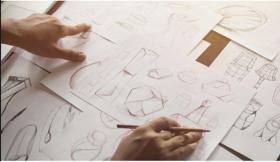
ENTRIVE STUDIO
Netherlands
With our 10+ years of experience in product development and manufacturing, we assist our clients to launch their idea with outstanding design. We advise in all stages on the road to market, including crowdfunding, sourcing and fulfilment. In the first step we explore your idea and your business's needs and create a project plan. After this, several concept designs are created by sketching, 3D design, and prototyping. The design is then further developed by CAD design, 3D printing and design for manufacturing. At the end, we help you with the final prototype, tech pack and help you find the right sourcing agent or manufacturer. We assist the setting up of production with expert advice on manufacturing. In case of low volume production (less than 200 pieces a year), we can make the product in our studio.
Request for a quote
SUVIS GMBH
Germany
The Suvis GmbH also deals with the application of modern numerical methods for the lay out and optimisation of various separator types like cyclones. A typical application of these computation methods is the computer aided investigation of particle separation from gases in cyclones. The prediction of the separation efficiency allows the reliable optimisation of conventional cyclones and the development of completely novel high efficiency cyclones. With that, very often expensive filter units, wet cleaner, or costly electro filters can be replaced or completed. When applying numerical methods (CFD simulations) to cyclones one encounters the problem of strong curvature of the stream lines because of the resulting strong swirl flow and the abrupt change of flow direction towards the outlet tube. This means that the assumption of isotropic turbulence is not useful anymore.
Request for a quote
3D HUBS - DIGITAL MANUFACTURING PLATFORM
Netherlands
Online Rapid Prototyping Service by 3D Hubs: Our rapid prototyping processes: FDM SLA SLS Polyjet MJF DMLS CNC Upload your CAD files, get an instant quote and start production.
Request for a quote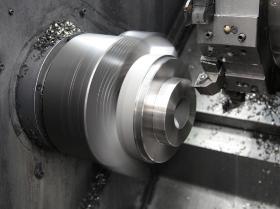
3D HUBS - DIGITAL MANUFACTURING PLATFORM
Netherlands
Online CNC turning service by 3D Hubs: From prototype to series production. With our wide range of CNC lathes & turning centres, you can produce high-precision and high-quality parts.
Request for a quote
FP.FORMGEBUNG
Germany
Process steps are essentially concept, development and implementation. In the conception phase, free associations and thoughts play the main role. essentially it is about approaches to problem-solving. different methods for finding ideas are used here. Well-known solutions and familiar processes are questioned, alternatives are considered. The development transfers the approaches to more or less concrete forms, the first geometries are created. flow e.g. ergonomic, technical and aesthetic parameters. Materials are considered, manufacturing processes are considered. In the implementation, the detailed processing of the draft takes place with the aim of conveying specifications to the manufacturers that are not technically feasible or economically viable. Hand sketches and 3D software are used. Visualizations can be created to get realistic ideas about the products. Drafts can be converted into models in our own model making workshop as well as with the 3D printer.
Request for a quoteResults for
Prototyping - Import exportNumber of results
31 ProductsCompany type
Category
- 3D printers (17)
- Prototypes, industrial (3)
- Outsourcing - product development (3)
- Industrial design (3)
- Vehicles - mechanical components and parts (2)
- 3D software (1)
- Mechanical engineering - custom work (1)
- Turning - steels and metals (1)
- CAD/CAM Computer Assisted Design/Computer Assisted Manufacturing - software (1)
- Gas filters (1)